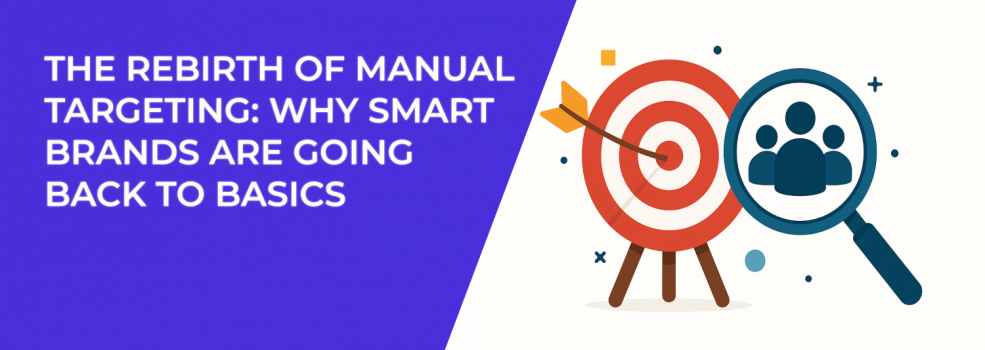For a while, automation felt like the answer to everything in digital advertising. Facebook’s targeting algorithms promised efficiency, simplicity, and scale—removing the burden of complex audience setups. Many advertisers bought into the idea that the platform would “know best.”
But with rising ad costs, declining engagement, and broader privacy changes, cracks have started to show. Brands that once trusted automation to deliver consistent results are now questioning whether they’ve outsourced too much control. This has given rise to a noticeable shift: the rebirth of manual targeting.
Why Manual Targeting Is Making a Comeback
Automated targeting thrives on data volume, not nuance. That works well for mass-market products with wide appeal. But for brands with unique audiences or products requiring context, automation often struggles.
Here’s the critical problem: algorithms optimize for the platform’s goals—impressions, clicks, or broad engagement—not necessarily your business goals. So while your campaign may reach thousands of “interested” users, how many of them will actually buy?
Manual targeting allows marketers to cut through this noise. By setting parameters that reflect real customer insights, you focus ad spend where it matters. It’s less about chasing reach and more about fostering relevance.
If you want to understand the broader shifts that led here, check out Facebook Ads Targeting Updates: How To Adapt in 2025.
The Benefits of Going Back to Basics
Re-engaging with manual targeting isn’t a step backward—it’s a recalibration. Advertisers who embrace it often rediscover advantages they didn’t realize they had lost.
-
Sharper segmentation — You’re not just targeting “parents,” you’re identifying “parents with young children interested in eco-friendly living.” That level of refinement is difficult to achieve with automation alone.
-
Creative alignment — When you know exactly who you’re targeting, ad messaging becomes sharper. The copy, visuals, and offers can speak directly to the group’s priorities.
-
Cost efficiency — Instead of paying for broad impressions that barely convert, you redirect budget to audiences that consistently prove their value.
-
Actionable insights — Manual setups create clearer cause-and-effect data. If one segment underperforms, you know precisely where the problem lies.
The real value here isn’t just better performance—it’s learning. Automation hides what’s working behind a black box. Manual targeting reveals the mechanics, which strengthens long-term strategy. For more on narrowing down profitable niches, see How to Use Facebook Detailed Targeting to Reach Micro-Niche Audiences.
Practical Tips for Manual Targeting
Transitioning back to manual targeting doesn’t mean discarding everything you’ve learned. The key is to reintroduce intentionality into audience creation.
-
Revisit your core customer profile. Go beyond surface demographics. What drives your customers’ decisions? A skincare brand, for example, may find that “eco-conscious buyers” convert better than the broader “beauty product” audience.
-
Layer targeting for depth. Combine multiple factors—demographics, interests, and behaviors—to create profiles that resemble your actual buyers. A business coach might target “entrepreneurs” who also “engage with productivity apps” for a much stronger fit. If you’re new to layering, How to Layer Detailed Targeting for Hyper-Specific Facebook Audiences breaks it down clearly.
-
Exclude to refine. Too often, advertisers think only in terms of inclusion. But exclusions are just as powerful. By removing job seekers, students, or competitors from your audience, you ensure budget isn’t wasted on irrelevant clicks. You can learn more in When to Use Exclude Targeting on Facebook and Why It Matters.
-
Run micro-tests. Don’t launch massive campaigns right away. Instead, test smaller, highly defined groups. A clothing retailer could try separate campaigns for “sustainable fashion enthusiasts” and “discount shoppers” to see which delivers higher ROAS.
Each of these steps brings clarity. Instead of letting Facebook decide, you actively define the edges of your market. That level of precision sharpens every dollar you spend.
Balancing Manual Targeting and Automation
The smartest advertisers aren’t abandoning automation altogether. They’re combining it with manual tactics to get the best of both worlds.
For example, you might build carefully crafted manual audiences but allow Facebook’s algorithm to optimize bidding and placements. This way, you decide who to target, while automation helps determine how to reach them efficiently.
Think of it as setting the rules of the game. The algorithm is the referee, but you still control the players on the field. Without your oversight, the system could steer your campaign toward easy wins that don’t matter to your bottom line.
If you’re wondering how to combine both approaches effectively, How to Combine Advantage+ and Manual Targeting for Smarter Campaigns offers a detailed guide.
When Manual Targeting Makes the Most Sense
Not every campaign benefits equally from manual targeting. There are specific contexts where its value is clearest:
-
Niche products. When you’re selling to a specific audience, broad targeting rarely works. Manual controls help you zero in.
-
High-ticket purchases. The more expensive the product, the more selective your targeting should be. A luxury travel package won’t sell well through generic interest groups.
-
Market testing. If you’re experimenting with new messaging or positioning, manual targeting lets you see how distinct groups respond.
-
Budget-sensitive campaigns. Smaller budgets demand efficiency. Manual targeting ensures you’re not paying for wasted impressions.
While brand-awareness campaigns may still benefit from automation’s reach, conversion-focused efforts often perform best with manual precision. If you’ve struggled with wasted spend, you’ll also find Why Facebook Ads Fail: 7 Targeting Issues You Didn’t Know About helpful.
Final Thoughts
Manual targeting is reemerging not because automation has failed, but because advertisers have learned the limits of “set it and forget it.” Control, context, and human insight are still irreplaceable in marketing.
Brands that strike the right balance—leveraging automation for efficiency while relying on manual targeting for relevance—are the ones seeing stronger, more sustainable results.
The trend isn’t about nostalgia. It’s about smarter marketing in a crowded space. And for those willing to put in the effort, going back to basics may just be the most modern move you can make.
For more strategies to sharpen your campaigns, explore Custom vs Lookalike Audiences: What Works Best for Facebook Campaigns? and The Science of Scaling Facebook Ads Without Killing Performance.

